|
|
|
Sort Order |
|
|
|
Items / Page
|
|
|
|
|
|
|
| Srl | Item |
| 1 |
ID:
122662
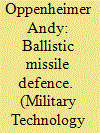

|
|
|
|
|
| Publication |
2012.
|
| Summary/Abstract |
The current generation of ballistic missile defence (BMD) system is intended to defence Europe against rogue state threats expected in the near future- launched missile threats from the Middle East, most notable Iran and the protect the US from medium and long range missiles from North Korea and other nascent WMD wielding states.
|
|
|
|
|
|
|
|
|
|
|
|
|
|
|
|
| 2 |
ID:
121708
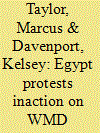

|
|
|
|
|
| Publication |
2013.
|
| Summary/Abstract |
The Egyptian delegation walked out of a meeting of member states of the nuclear Nonproliferation Treaty (NPT) on April 29 to protest the failure to convene a conference on creating a zone free of weapons of mass destruction (WMD) in the Middle East, and an Egyptian Foreign Ministry official said May 17 that other steps may follow.
|
|
|
|
|
|
|
|
|
|
|
|
|
|
|
|
| 3 |
ID:
087000
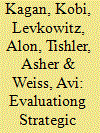

|
|
|
|
|
| Publication |
2009.
|
| Summary/Abstract |
This study evaluates the order of magnitude of the monetary cost of achieving an international strategic limitation agreement on weapons of mass destruction (WMD) in an asymmetric arms race, with applications to the Israeli-Syrian and the North versus South Korean conflicts. It extends the Kagan et al. (2005) framework and develops a model of resource allocation between expenditure on civilian government consumption and on security in a non-cooperative (Cournot) arms race between a developed country and a less-developed country. The model is used to predict the optimal mix of weapons of the two countries engaged in the arms race, and to evaluate the applicability of international strategic WMD limitation agreements. Applying the model to the arms race between Israel and Syria shows that if considered from a purely monetary perspective, such an agreement, in which the monetary transfer to Syria is made by either Israel or a third party, is within reach. A strategic agreement to limit North Korea's WMD is also economically feasible, but only when the monetary transfer to North Korea is shouldered by a third party such as the USA or a coalition of neighboring countries.
|
|
|
|
|
|
|
|
|
|
|
|
|
|
|
|
| 4 |
ID:
089958


|
|
|
|
|
| Publication |
2009.
|
| Summary/Abstract |
After September 11, 2001, President George W. Bush's administration presented a national security agenda that held two key goals: the denial of safe havens to terrorist groups with international reach, and the prevention of terrorist groups from acquiring Weapons of Mass Destruction (WMD). In 2002, a terrorist group, Ansar al-Islam, operating out of a camp in Khurmal, northeast Iraq, was reportedly developing cyanide gas, toxic poisons, and ricin for potential use against Europe and the United States. The Joint Chiefs of Staff unanimously supported, and formally presented to the White House, a military operation to destroy the Ansar camp. This article, based on research and interviews with senior military and civilian officials, assesses four plausible explanations for why President Bush deferred attacking the only place in Iraq that was producing WMD, albeit in small quantities, before the 2003 war. It argues that President Bush made the mistake of bypassing the Khurmal operation, because of concerns that it could have disrupted plans to remove Saddam Hussein from power. In addition, the article assesses what lessons learned from the decision not to attack Khurmal could be applied to other non-uses of limited force.
|
|
|
|
|
|
|
|
|
|
|
|
|
|
|
|
| 5 |
ID:
131298
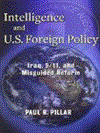

|
|
|
|
|
| Publication |
New York, Columbia University Press, 2014.
|
| Description |
xvi, 413p.Pbk
|
| Standard Number |
9780231157933
|
|
|
|
|
|
|
|
|
|
|
|
Copies: C:1/I:0,R:0,Q:0
Circulation
| Accession# | Call# | Current Location | Status | Policy | Location |
| 057760 | 327.1273/PIL 057760 | Main | On Shelf | General | |
|
|
|
|
| 6 |
ID:
084280


|
|
|
| 7 |
ID:
107374


|
|
|
|
|
| Publication |
2011.
|
| Summary/Abstract |
One of the most sought-after prizes in international disarmament and nonproliferation diplomacy is a Middle East free of weapons of mass destruction (WMD). In such a conflict-ridden area with a history of mistrust and animosity where chemical weapons were used in the past, the prospect of renewed WMD use is all too possible.[1] For these reasons, a WMD-free zone in the Middle East is not only an aspirational goal, but a matter of practical urgency.
|
|
|
|
|
|
|
|
|
|
|
|
|
|
|
|
| 8 |
ID:
191979


|
|
|
|
|
| Summary/Abstract |
Incidents of noncompliance with existing multilateral arms-control treaties and subsequent enforcement actions can help to inform the design of future treaties. This article uses examples of noncompliance with the 1972 Biological and Toxin Weapons Convention, 1993 Chemical Weapons Convention, and 1968 Treaty on the Non-Proliferation of Nuclear Weapons to identify factors that have determined the nature of compliance-enforcement actions. The punitivist model of treaty design and enforcement is introduced and is used alongside the established transformationalist and managerialist models to analyze incidents of noncompliance and identify factors shaping compliance-enforcement actions. Two such factors are found to play important roles: the scale of acts of noncompliance and the identity of the perpetrator. The scale of the act of noncompliance dictates whether the compliance-enforcement actions specified in the treaty text are followed. Responses to large-scale acts do follow the treaty-specified actions, while the small-scale acts analyzed in this article all elicit a managerialist response of consultation and cooperation, regardless of actions stipulated in the treaty text. In all cases, the identity of the perpetrator is crucial: the permanent members of the UN Security Council and their allies are fundamentally impervious to punitive measures.
|
|
|
|
|
|
|
|
|
|
|
|
|
|
|
|
| 9 |
ID:
107378
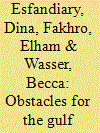

|
|
|
|
|
| Publication |
2011.
|
| Summary/Abstract |
Judging by their official statements, the establishment of a zone free of weapons of mass destruction (WMD) in the Middle East ranks high on the list of policy priorities of the six member states of the Gulf Cooperation Council (GCC)-Bahrain, Kuwait, Oman, Qatar, Saudi Arabia, and the United Arab Emirates (UAE).[1] As countries bordering a once-proliferating, aggressive state (Iraq); facing another suspected of seeking a nuclear weapons capability and bent on regional hegemony (Iran); and living in the vicinity of nuclear powers outside the nuclear Nonproliferation Treaty (NPT) regime (India, Israel, and Pakistan), they arguably have a paramount security interest in its rapid formation.
|
|
|
|
|
|
|
|
|
|
|
|
|
|
|
|
| 10 |
ID:
107382


|
|
|
|
|
| Publication |
2011.
|
| Summary/Abstract |
Efforts to decide on the facilitator and host country for a planned 2012 conference on creating a zone free of weapons of mass destruction (WMD) in the Middle East are hampered by disagreements not only over the individual person and country for those roles, but also over fundamental points of the process for making the choices, interviews with participants in the process indicate.
|
|
|
|
|
|
|
|
|
|
|
|
|
|
|
|
| 11 |
ID:
107375


|
|
|
|
|
| Publication |
2011.
|
| Summary/Abstract |
In 1974 the UN General Assembly adopted a resolution on the establishment of a nuclear-weapon-free zone in the Middle East. Since then, there have been no concrete steps toward that objective. The final document of the 2010 Nuclear Nonproliferation Treaty (NPT) Review Conference, with its commitments to a conference in 2012 on creating a zone free of nuclear weapons and other weapons of mass destruction (WMD) in the Middle East, opened the possibility of changing the situation.
|
|
|
|
|
|
|
|
|
|
|
|
|
|
|
|
| 12 |
ID:
162558


|
|
|
|
|
| Summary/Abstract |
This paper looks at issues of international normative-legal regulations regrading the prohibition and nonproliferation of biological weapons. We examine the views of the military-political leadership in major foreign states on threats to national security stemming from potential use of this type of weapons, and assess the condition and development of biological weapons abroad under the existing restrictions.
|
|
|
|
|
|
|
|
|
|
|
|
|
|
|
|
|
|
|
|
|